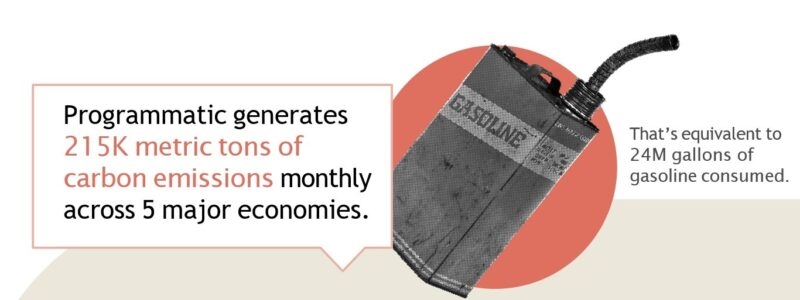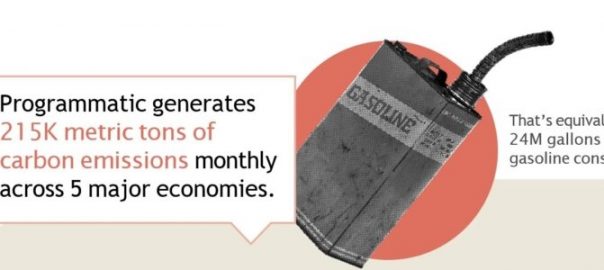As we come up to Earth Day, know that the media properties with the biggest carbon footprint are typically fraud, click-bait or offer low-value inventory.
“Bad” digital ad spending is very bad for the environment. That’s the finding of Scope3’s State of Sustainability Report which found that media properties with the biggest carbon footprint are typically fraud, click-bait or offer low-value inventory.
These ‘Climate Risk’ websites, which make up 10% of the domains in the five countries studied by the report — the U.S., U.K., France, Germany and Australia, contribute 33,500 metric tons (mt) of carbon dioxide equivalent (CO2e) greenhouse gases per month. That’s equal to driving a car 86,000,000 miles or 3,449 times around the earth. Between January 2020 and May 2022, $ 115 million was spent on advertising on these sites.

The big picture. Overall, the energy used by programmatic advertising in these five countries every month generates the same amount of greenhouse gas as 24 million gallons of gasoline, according to the report.
This includes energy used in
- Ad selection from servers and cloud computing; analytics; network traffic; storage; data providers; and vendor overhead.
- Media distribution via CMS; CDNs and hosting services.
- Consumer devices during views.
- Creative distribution from creative delivery including transfer and all vendors involved.
Global emissions per 1000 programmatic ad impressions are approximately 514.8 gCO2PM (grams of carbon dioxide and equivalent greenhouse gasses). That’s the same amount of energy as washing a load of laundry.
Average publisher emissions can range anywhere from as low as 187 gCO2PM all the way up to 1772 gCO2PM.
Why we care. Climate change is the greatest threat to human existence and we are running out of time to do anything about it. This is why every action matters.
It’s easy to get overwhelmed by the scale of the problem and think this one change won’t accomplish anything. Repurposing ad spend away from those problematic websites “only” cuts 33,500mt out of programmatic advertising’s monthly total of 215,000mt. Even if we could get that amount to zero, it is a fraction of a percent of the 50,000,000,000mt of greenhouse gases produced each year.
Here’s the thing: We’re in the marketing business. We’re all about the cumulative impact of incremental change in attitudes. We don’t know where the tipping point is for this change. We could be a very small step away from it. Every action matters in getting to that.
Doing less with more isn’t only in your own self-interest, it’s also good business. Retail giant Walmart has saved billions of dollars by requiring more environmentally friendly packaging for the products it sells.
What can be done: Each ad impression travels through an “advertising life cycle,” which starts with the programmatic selection process and ends when the ad is delivered. Every step along the way contributes to the ad’s emissions. Knowing the impact of each part of the journey will help you discover excess energy uses.
For example, ad selection is responsible for upwards of 60% of the energy used in programmatic advertising. You can lower that amount significantly by adjusting things like your programmatic supply chain.
The post ‘Bad’ digital ad spending can harm the environment appeared first on MarTech.
MarTech(5)






